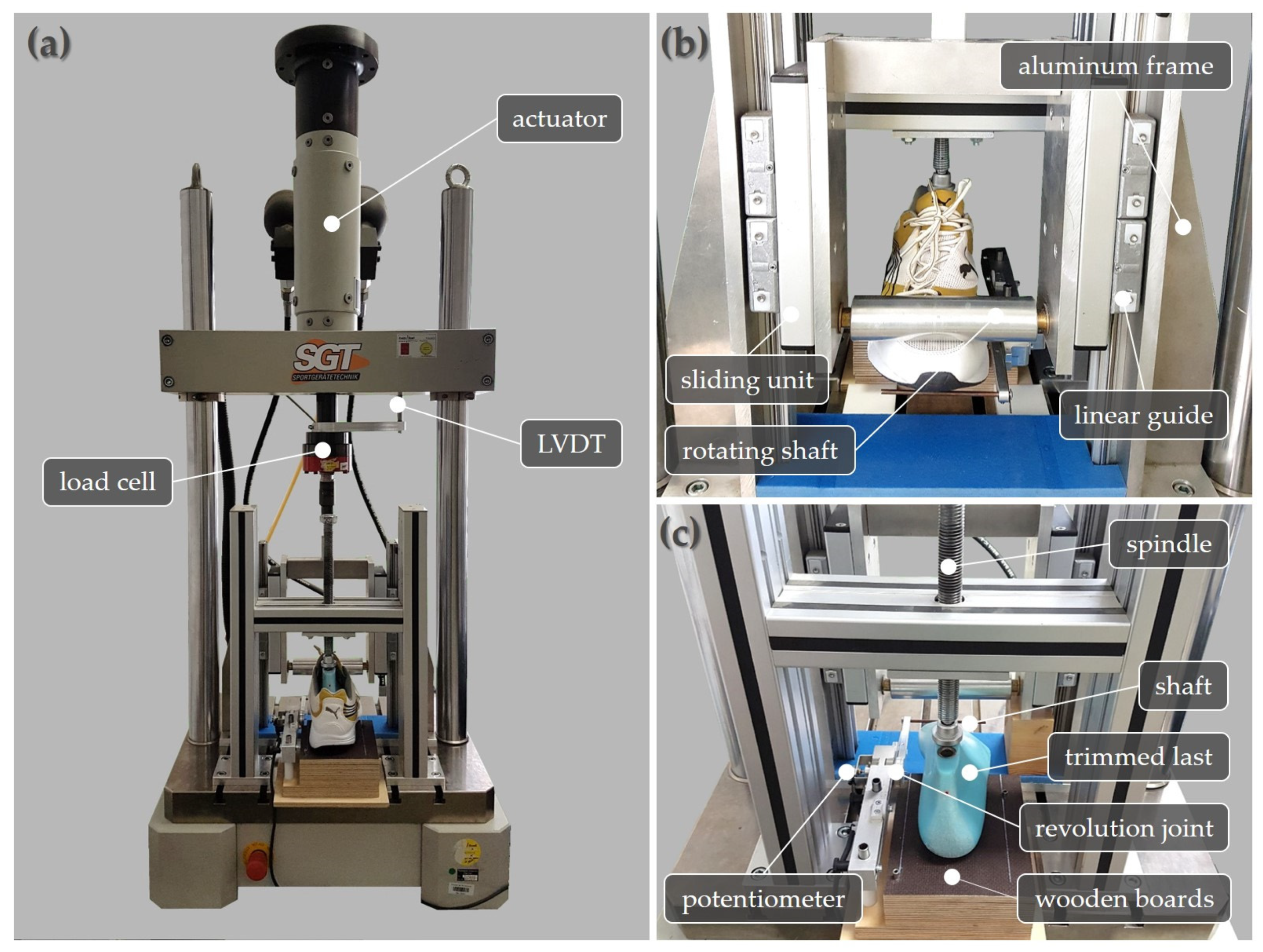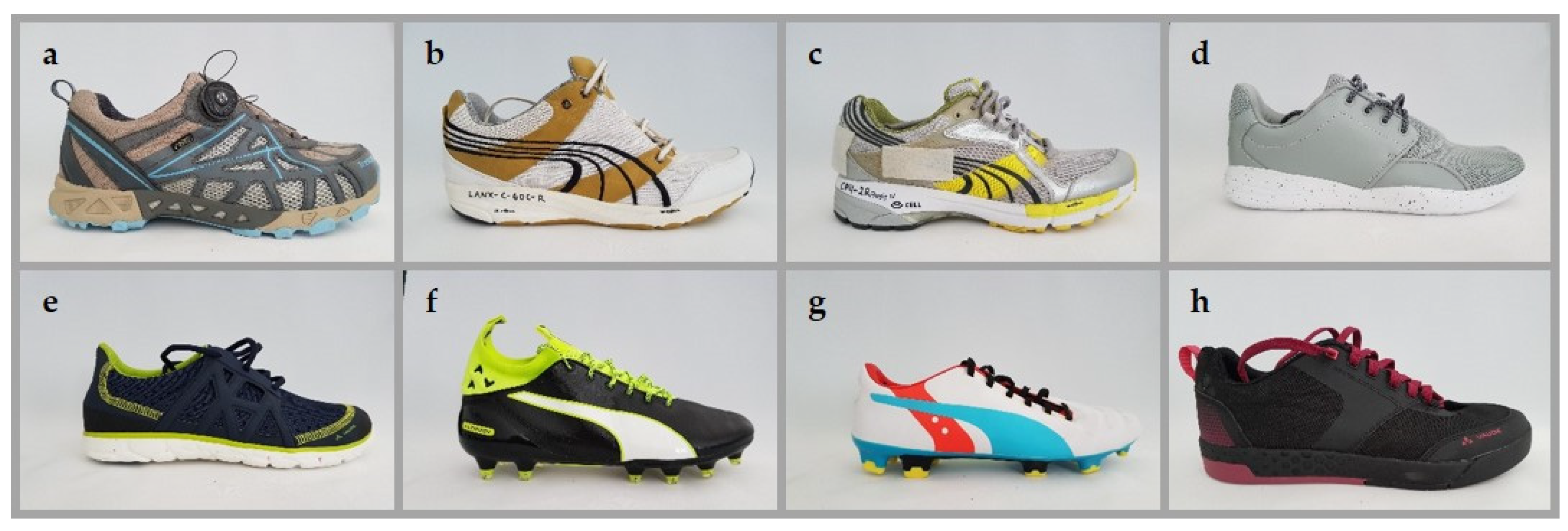How to Assess Repeatability and Reproducibility of a Mechanical Test? An Example for Sports Engineers †
Abstract
:1. Introduction
2. Materials and Methods
2.1. Mechanical Simulation
2.2. Testing Procedure
2.3. ANOVA Gage R&R
3. Results
4. Discussion
5. Conclusions
Conflicts of Interest
References
- Stefanyshyn, D.J.; Wannop, J.W. Biomechanics research and sport equipment development. Sports Eng. 2015, 18, 191–202. [Google Scholar] [CrossRef]
- Odenwald, S. Test Methods in the Development of Sports Equipment. In The Engineering of Sport 6; Moritz, E.F., Haake, S., Eds.; Springer: New York, NY, USA, 2006; pp. 301–306. ISBN 978-0-387-34678-6. [Google Scholar]
- Down, M.; Czubak, F.; Gruska, G.; Stahley, S.; Benham, D. Measurement Systems Analysis. Reference Manual, 4th ed.; Automotive Industry Action Group (AIAG): Detroit, MI, USA, 2010; ISBN 978-1-60-534211-5. [Google Scholar]
- Stefanyshyn, D.J.; Wannop, J.W. The influence of forefoot bending stiffness of footwear on athletic injury and performance. Footwear Sci. 2016, 8, 51–63. [Google Scholar] [CrossRef]
- Wannop, J.W.; Stefanyshyn, D.J. Special issue: Bending stiffness: Performance and injury effects. Footwear Sci. 2016, 8, 49–50. [Google Scholar] [CrossRef]
- Schwanitz, S. Systematische Entwicklung mechanischer Simulationen der Interaktion von Sportler, Sportgerät und Umwelt. In Sporttechnologie zwischen Theorie und Praxis VI: Beiträge aus dem Workshop SpoTec 2015 “Aktuelle Trends in Sport und Technik" incl. “Gangworkshop"; Witte, K., Edelmann-Nusser, J., Eds.; Shaker Verlag: Aachen, Germany, 2015; pp. 29–38. ISBN 978-3-8440-3974-0. [Google Scholar]
- Krumm, D.; Schwanitz, S.; Odenwald, S. Development and reliability quantification of a novel test set-up for measuring footwear bending stiffness. Sports Eng. 2013, 16, 13–19. [Google Scholar] [CrossRef]



| Appraiser /Trial # | Part | Average | |||||||||
|---|---|---|---|---|---|---|---|---|---|---|---|
| 1 | 2 | 3 | 4 | 5 | 6 | 7 | 8 | ||||
| A | 1 | 0.49 | 0.13 | 0.19 | 0.08 | 0.08 | 0.13 | 0.11 | 0.31 | 0.190 | |
| 2 | 0.42 | 0.11 | 0.17 | 0.08 | 0.07 | 0.14 | 0.09 | 0.29 | 0.172 | ||
| Average | 0.458 | 0.122 | 0.179 | 0.080 | 0.071 | 0.137 | 0.100 | 0.301 | 0.181 | ||
| Range | 0.067 | 0.017 | 0.017 | 0.002 | 0.008 | 0.007 | 0.018 | 0.022 | 0.020 | ||
| B | 1 | 0.46 | 0.13 | 0.18 | 0.08 | 0.08 | 0.14 | 0.09 | 0.35 | 0.189 | |
| 2 | 0.50 | 0.14 | 0.20 | 0.08 | 0.08 | 0.17 | 0.09 | 0.32 | 0.189 | ||
| Average | 0.482 | 0.137 | 0.193 | 0.083 | 0.080 | 0.153 | 0.090 | 0.322 | 0.194 | ||
| Range | 0.045 | 0.008 | 0.019 | 0.001 | 0.004 | 0.026 | 0.004 | 0.028 | 0.017 | ||
| Part Average | 0.470 | 0.129 | 0.186 | 0.081 | 0.075 | 0.145 | 0.095 | 0.317 | 0.187 | ||
| 0.395 | |||||||||||
| Source | DF | SS | MS | F |
|---|---|---|---|---|
| Appraiser | 1 | 0.00127 | 0.00127 | 4.1 |
| Parts | 7 | 0.53699 | 0.07671 | 247.55 * |
| Appraiser by part | 7 | 0.00107 | 0.00015 | 0.49 |
| Equipment | 16 | 0.00496 | 0.00031 | |
| Total | 31 | 0.54428 |
| Standard Deviation | % Total Variation | % Contribution | |
|---|---|---|---|
| Repeatability (EV) | 0.018 | 12.6 | 1.6 |
| Reproducibility (AV) | 0.008 | 6.0 | 0.4 |
| Appraiser by part (INT) | 0 | 0 | 0 |
| GRR | 0.019 | 13.9 | 1.9 |
| Part (PV) | 0.138 | 99.0 | 98.1 |
| Note: | Measurement System may be acceptable for the application –should be approved by the customer. | ||
| Number of distinct data categories (ndc) = 10 | Total variation (TV) = 0.140 | ||
| MSA—If Repeatability is Large Compared to Reproducibility, the Reasons May Be: | Self-Assessment |
|---|---|
| The instrument needs maintenance. | Not applicable. Bending unit was maintained beforehand. Servo-hydraulic machine is calibrated. Stroke-time curves of all trails were identical. |
| The gage may need to be redesigned to be more rigid. | Not applicable. Rigidity of the test rig (20 kN machine frame) including load cell (10 kN) was sufficient compared to peak loads. |
| The clamping or location for gaging needs to be improved. | Applicable. Clamping of samples needs to be revised. |
| There is excessive within-part variation. | Applicable. Possibly wear of the samples in repeated trials. |
Publisher’s Note: MDPI stays neutral with regard to jurisdictional claims in published maps and institutional affiliations. |
© 2020 by the authors. Licensee MDPI, Basel, Switzerland. This article is an open access article distributed under the terms and conditions of the Creative Commons Attribution (CC BY) license (https://creativecommons.org/licenses/by/4.0/).
Share and Cite
Krumm, D.; Schwanitz, S.; Odenwald, S. How to Assess Repeatability and Reproducibility of a Mechanical Test? An Example for Sports Engineers. Proceedings 2020, 49, 122. https://doi.org/10.3390/proceedings2020049122
Krumm D, Schwanitz S, Odenwald S. How to Assess Repeatability and Reproducibility of a Mechanical Test? An Example for Sports Engineers. Proceedings. 2020; 49(1):122. https://doi.org/10.3390/proceedings2020049122
Chicago/Turabian StyleKrumm, Dominik, Stefan Schwanitz, and Stephan Odenwald. 2020. "How to Assess Repeatability and Reproducibility of a Mechanical Test? An Example for Sports Engineers" Proceedings 49, no. 1: 122. https://doi.org/10.3390/proceedings2020049122





